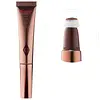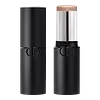What's inside
What's inside
 Key Ingredients
Key Ingredients

 Benefits
Benefits

 Concerns
Concerns

 Ingredients Side-by-side
Ingredients Side-by-side

Water
Skin ConditioningCyclopentasiloxane
EmollientIsododecane
EmollientMica
Cosmetic ColorantCetyl PEG/PPG-10/1 Dimethicone
EmulsifyingPolyglyceryl-4 Diisostearate/Polyhydroxystearate/Sebacate
EmulsifyingTriethylhexanoin
MaskingPhenylisopropyl Dimethicone
Skin ConditioningGlycerin
HumectantSilica
AbrasiveHydrogenated Starch Hydrolysate
HumectantDisteardimonium Hectorite
StabilisingHydroxyacetophenone
AntioxidantSodium Chloride
MaskingAlcohol
Antimicrobial1,2-Hexanediol
Skin ConditioningCaprylyl Glycol
EmollientTrisodium Ethylenediamine Disuccinate
Lindera Strychnifolia Root Extract
Skin ConditioningPhenoxyethanol
PreservativeEthylhexylglycerin
Skin ConditioningTitanium Dioxide
Cosmetic ColorantIron Oxides
Water, Cyclopentasiloxane, Isododecane, Mica, Cetyl PEG/PPG-10/1 Dimethicone, Polyglyceryl-4 Diisostearate/Polyhydroxystearate/Sebacate, Triethylhexanoin, Phenylisopropyl Dimethicone, Glycerin, Silica, Hydrogenated Starch Hydrolysate, Disteardimonium Hectorite, Hydroxyacetophenone, Sodium Chloride, Alcohol, 1,2-Hexanediol, Caprylyl Glycol, Trisodium Ethylenediamine Disuccinate, Lindera Strychnifolia Root Extract, Phenoxyethanol, Ethylhexylglycerin, Titanium Dioxide, Iron Oxides
C15-19 Alkane
SolventCaprylic/Capric Triglyceride
MaskingMica
Cosmetic ColorantHelianthus Annuus Seed Wax
Skin ConditioningSaccharomyces Ferment
Skin ConditioningCoco-Caprylate/Caprate
EmollientSilica
AbrasivePhytosteryl/Octyldodecyl Lauroyl Glutamate
Skin ConditioningPolyglyceryl-2 Triisostearate
EmulsifyingIris Florentina Root Extract
MaskingAluminum Hydroxide
EmollientParfum
MaskingBrassica Campestris Seed Oil
Skin ConditioningEuphorbia Cerifera Wax
Copernicia Cerifera Wax
Lauroyl Lysine
Skin ConditioningDisteardimonium Hectorite
StabilisingOpuntia Ficus-Indica Flower Extract
Skin ConditioningCamelina Sativa Seed Oil
Skin ConditioningPentaerythrityl Tetra-Di-T-Butyl Hydroxyhydrocinnamate
AntioxidantWater
Skin ConditioningTocopherol
AntioxidantSodium Benzoate
MaskingPotassium Sorbate
PreservativeCI 77891
Cosmetic ColorantCI 77491
Cosmetic ColorantCI 77492
Cosmetic ColorantCI 77499
Cosmetic ColorantC15-19 Alkane, Caprylic/Capric Triglyceride, Mica, Helianthus Annuus Seed Wax, Saccharomyces Ferment, Coco-Caprylate/Caprate, Silica, Phytosteryl/Octyldodecyl Lauroyl Glutamate, Polyglyceryl-2 Triisostearate, Iris Florentina Root Extract, Aluminum Hydroxide, Parfum, Brassica Campestris Seed Oil, Euphorbia Cerifera Wax, Copernicia Cerifera Wax, Lauroyl Lysine, Disteardimonium Hectorite, Opuntia Ficus-Indica Flower Extract, Camelina Sativa Seed Oil, Pentaerythrityl Tetra-Di-T-Butyl Hydroxyhydrocinnamate, Water, Tocopherol, Sodium Benzoate, Potassium Sorbate, CI 77891, CI 77491, CI 77492, CI 77499
 Reviews
Reviews

Ingredients Explained
These ingredients are found in both products.
Ingredients higher up in an ingredient list are typically present in a larger amount.
Disteardimonium Hectorite comes from the clay mineral named hectorite. It is used to add thickness to a product.
It can also help stabilize a product by helping to disperse other ingredients.
Hectorite is a rare, white clay mineral.
Learn more about Disteardimonium HectoriteMica is a naturally occurring mineral used to add shimmer and color in cosmetics. It can also help improve the texture of a product or give it an opaque, white/silver color.
Serecite is the name for very fine but ragged grains of mica.
This ingredient is often coated with metal oxides like titanium dioxide. Trace amounts of heavy metals may be found in mica, but these metals are not harmful in our personal products.
Mica has been used since prehistoric times throughout the world. Ancient Egyptian, Indian, Greek, Roman, Aztec, and Chinese civilizations have used mica.
Learn more about MicaSilica, also known as silicon dioxide, is a naturally occurring mineral. It is used as a fine, spherical, and porous powder in cosmetics.
Though it has exfoliant properties, the function of silica varies depending on the product.
The unique structure of silica enhances the spreadability and adds smoothness, making it a great texture enhancer.
It is also used as an active carrier, emulsifier, and mattifier due to its ability to absorb excess oil.
In some products, tiny microneedles called spicules are made from silica or hydrolyzed sponge. When you rub them in, they lightly polish away dead skin layers and enhance the penetration of active ingredients.
Learn more about SilicaWater. It's the most common cosmetic ingredient of all. You'll usually see it at the top of ingredient lists, meaning that it makes up the largest part of the product.
So why is it so popular? Water most often acts as a solvent - this means that it helps dissolve other ingredients into the formulation.
You'll also recognize water as that liquid we all need to stay alive. If you see this, drink a glass of water. Stay hydrated!
Learn more about Water